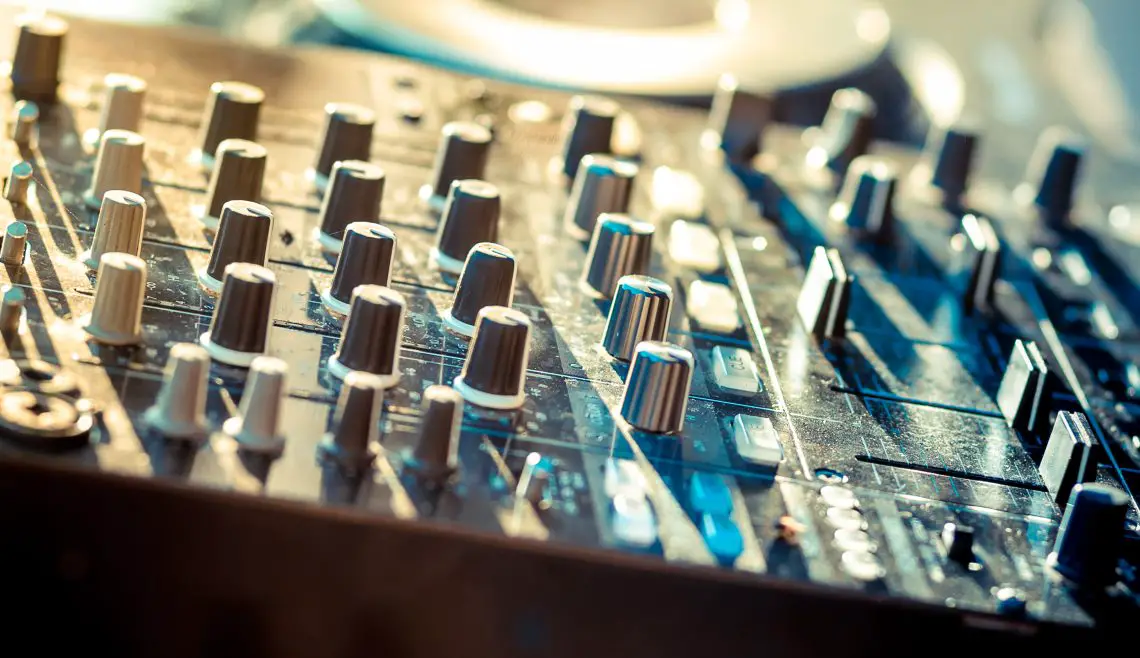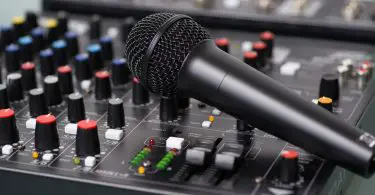An audio mixer is given a crucial job in the world of music. The mixer must reproduce audio at a level that doesn’t distort the many inputs and give the engineer the ability to modify and tweak various settings to the band’s desire.
There are many types of sound mixers, and every mixer will produce a slightly different sound. There are also many nuances between most mixers. There are line mixers and powered mixers, studio mixers and live mixers, analog mixers and digital mixers, and every one of these pieces of technology serves a specific purpose.
This 16-Input powered mixer provides enough comfort and flexibility to save any engineer or musician from experiencing sound difficulties on tour, producing a smooth and clean sound.
This 1000-Watt-RMS powered mixer is a great budget option, complete with 8 mic/line channels & 48v phantom power for a condenser microphone.
I have been working with audio since I was eleven years old. I am currently in the process of receiving two bachelor of science degrees, one in audio technology and one in computer science. I currently attend American University, a University that received recognition as the number one school for audio production.
I have worked on creating an assortment of technologies pertaining to audio including but not limited to, microphones, digital instruments, digital audio signal processing software, and speakers. I have also worked in American University’s state-of-the-art recording studio, producing, recording, mixing, and mastering several bands from multiple genres.
I worked as a monitor sound engineer for two music venues where I worked closely with bands and the front-of-house (FOH) engineer to ensure that audio equipment and audio reproduction worked well for every party.
-
 Check on Musician's Friend Check on eBay
Check on Musician's Friend Check on eBayThis 16-Input powered mixer provides enough comfort and flexibility to save any engineer or musician from experiencing sound difficulties on tour, producing a smooth and clean sound.
-
 $529.00Check on Amazon Check on eBay
$529.00Check on Amazon Check on eBayThis mixer, with 16 Channels can provide for almost any three to four piece band.
06/28/2025 11:19 pm GMT -
 $2,647.49Check on Amazon Check on Musician's Friend
$2,647.49Check on Amazon Check on Musician's FriendThis 12-Channel, 1600-Watt desktop mixer is a beast when it comes to accessories and features.
06/28/2025 09:06 pm GMT -
 $288.00Check on Amazon Check on eBay
$288.00Check on Amazon Check on eBayThis 1000-Watt-RMS powered mixer is a great budget option, complete with 8 mic/line channels & 48v phantom power for a condenser microphone.
06/28/2025 11:15 pm GMT -
 $699.99Check on Amazon Check on eBay
$699.99Check on Amazon Check on eBay12-input Stereo Powered Mixer w/ DSP Effects
06/28/2025 11:17 pm GMT
What Is A Live Sound Mixer?
A live sound mixer is essential to any performance-centric venue. A sound mixer will be needed to play various audio sources simultaneously. As mentioned above, there are many types of mixers that range from studio to live applications. There are many differences between a live and studio mixer. But an essential and realistic factor is the weight that comes with utilizing a live sound mixer.
When you are in the studio, you can assume that the mixer will not move for upwards of five years. On the other hand, a live sound mixer will have to be portable because, although it may not leave the venue, there are moments when you may need to change locations, allow a band to use their own equipment, or add a new piece of equipment.
The live sound mixer allows several sound sources to emerge from a single sound system. This brings me to the next point of actually adding each of these sources together.
Unpowered vs. Powered
The differences between an unpowered and powered sound mixer are subtle, yet, the implications will dictate how you work with the machine. When utilizing a mixer, it is essential to have a method of powering the equipment; this is the key difference between the powered and unpowered sound mixer.
An unpowered sound mixer is usually considered more powerful, versatile, and extendable for the audio enthusiast. Alternatively, the powered sound mixer is considered perfect for the average musician. I firmly agree with both of these assumptions — let me explain.
An unpowered mixer can only turn on if you have a power source at your disposal. This usually means that an unpowered mixer will remain stationary for most of its usable life. This lack of integration with a power source gives the manufacturer or producer more room to extend its power, creating a more versatile machine.
On the other hand, the powered mixer tends to be a lightweight machine with fewer features, but more accessible and mobile than its counterpart. This makes the powered machine perfect for travel and the “pick up and play” musician.
Powered Mixer
Pros
Mixer and amplifier in one convenient machine
Perfect for live recording
Cons
Less mixing “finesse”
Unpowered Mixer
Pros
Higher quality potential in top-of-the-line models
Higher mixing capabilities
Perfect for the home or professional studio
Cons
Not durable
Stationary
Requires a separate amplifier
Mixer Channels
Arguably the most important aspect of a sound mixer is the number of channels it can work with. A channel is interchangeable with input. However, some channels may be more complicated than others. Often referred to as channel strips, this is considered the “guts” of a channel and an important feature for most consumers.
The channel strip marries many parts of an older complicated system into one seamless piece of technology. In the past, audio engineers were responsible for connecting a power source, input and output cables, and the channel together into a signal path.
However, modern day mixers marry all three components together into something called a mixer channel. As time has progressed, these mixer channels have become more complicated, including options to EQ, compress, and distort different signals before they leave the mixer and reach the speakers.
Input and Output
Like most audio technologies, the input and output of your system are integral to your purchase. Among the many options, there are many that you don’t need to consider based on any hardware you have previously purchased, your future needs, and your current needs.
If you are planning to play music for the rest of your life, it is better to go with an option that contains a large amount of input and output jacks. Alternatively, if you are a part-time musician, perhaps you don’t need a monitor to begin with.
Consider the hardware you have previously purchased. Do you use condenser microphones? Ensure your live mixer has phantom power compatibility.
The most overlooked component when purchasing a mixer is compatibility with your speakers. Some brands do not offer hardware compatible with certain types of speakers. In order to save yourself the trouble, double check what hardware your mixer can output signal to.
Buses and Signal Routing
Buses and signal routing are important for musicians who must be able to add effects and other processing to their music. Bussing allows these effects to slightly effect a “copy” of the audio signal instead of affecting the original signal. A bus will increase the quality of any effects that are played through your system.
Signal routing is important to maintain control over the path in which each audio source goes through. To add effects like guitar pedals, electronic drums, etc. you must have complete domain over your signal’s route.
Meters and Peak Lights
You may not use this feature if you are a musician, however, as an audio engineer, this feature is critical to the quality of your audio playback. As many people know, the audio peaks and clips can cause distortion that is unpleasant for the sound system and the audience.
The easiest way to understand how your audio is affecting the system is through peak monitoring. Unfortunately, this feature is not available on every mixer, although it should be.
Digital Vs. Analog
Finally, the distinction between an analog and digital mixer should be mentioned before purchasing.
Analog Mixers
An analog mixer provides ease-of-use as soon as you understand the parameters of the machine. Audio is considered an analog phenomenon; thus, it is possible to modify and affect it through extensive circuitry and wires. An analog mixer does exactly that, and is considered the “go-to” mixer for many live sound engineers.
This is heavily based on the idea that analog creates a better sound than digital because analog produces “warmer” frequencies. Many live engineers will explain that the whole environment of live sound lends itself to a less-than-desired quality so having an analog mixer remedies the situation.
Digital Mixers
Digital mixers have become more popular as technology has improved. A digital mixer knows no bounds regarding capability and audio reproduction (as long as the hardware allows).
Digital mixers can modify an audio source to whatever extent you wish because any incoming signal will convert to binary (1s and 0s that a computer can read) and affect that signal based on how you set up the machine. A great reason why many live engineers are switching to digital is based on the compatibility with modern plugins.
Many companies like Waves create cross-platform plugins that allow you to set up your live performance with the same signal chain that was used during recording.
Top Pick: Yamaha EMX5016CF
This 16-Input powered mixer provides enough comfort and flexibility to save any engineer or musician from experiencing sound difficulties on tour, producing a smooth and clean sound.
The Yamaha EMX5016CF is the best current live powered mixer based on its many features but also the amazing, smooth, and clean sound that it produces in a live scenario.
It is compact and portable but can handle large audiences with 500 watts per channel. The power output of the speaker is 500 watts, but it’s unclear if this is RMS or another measurement. It has 16 input channels (8 mono, 4 stereo) with switchable phantom power and 3-band EQ on all channels
- 8 mono channels have mid frequency sweep controls for enhanced equalization potential
- It can be expanded with external gear or integrated into larger systems with insert patch points and external outs/ins
- It has one-knob compressors on all mono channels and a digital 9-band stereo graphic equalizer with presets and user memory locations
- It has an automatic EQ matching system and a feedback suppressor system
- It includes two top performance Yamaha SPX digital effect processors built-in
The Yamaha mixer maintains enough input and output jacks for most four-piece bands. You can hook up 12 XLR cables while still having the extra accessibility of four stereo inputs. (It is a 12-channel mixer, not a 16-channel mixer, but it does have stereo capabilities on the top four channels with phono plugs.) Along with the stereo input, the Yamaha has a maximizer circuit design. This means that the stereo output is enhanced in terms of loudness and quality.

Credit: Yamaha Corporation
The EMX is incredibly capable for a small to medium-sized venue. The extensive audio processing capabilities will allow your band to simply buy this machine and utilize the onboard processing system instead of bringing your hardware along with it. You can use both guitar pedals/other effects in conjunction with the Yamaha.
The Yamaha offers single-knob compression on eight of the mono inputs. Although single knob compression takes away from flexibility, it allows for quick audio enhancement/changes during performances.
The EMX has a stereo digital graphic equalizer so you can truly see what you are doing to the audio spectra of your music. Lastly, there is a wide array of echoes and reverbs with the option of integrating tremolo, chorus, distortion, wah-wah, doublers, pitch change, or gating into your audio signal.
The EMX is a perfect companion for any musician or live engineer from a practical perspective as well. As mentioned earlier, powered monitors are meant to be relatively portable because of the internal amplifier. It is compact at about 24 by 21 by 11 inches.
It weighs only 30 pounds (11kg), extremely light in comparison to many powered monitors. It even has a convenient handle for easy transport. The assortment of effects and monitoring capabilities provide an even mix between power and capability. To top it all off, the Yamaha offers a great peak meter that ranges from -20 dB to +5 dB.
The mixer has XLR and jack inputs, analog compression on eight channels, and EQ controls with two auxiliary output sends and two separate independent effects channels.
The multi-band compressor is powerful and has a separate button for activation.
The mixer has LED indicators for signal level, smooth faders, and individual switch off for each channel.
The mixer has a digital section on the back with a graphic and the ability to change and store settings.
I’d heartily recommend this mixer for rock bands playing in clubs.
The Yamaha EMX5016CF can be used as a primary mixing monitor or a great “emergency” option that will provide enough comfort and flexibility to save any engineer or musician from experiencing sound difficulties during a tour.
Honorable Mentions:
Behringer EuroPower PMP4000
This mixer, with 16 Channels can provide for almost any three to four piece band.
Behringer is known throughout the audio industry as a great quality manufacturer. In creating this list, this mixer and the Yamaha were close in rank. However, Yamaha’s maximized circuitry for enhanced stereo ultimately pushed this one ahead.

Credit: BEHRINGER
With 16 channels, eight of which including the option of phantom power, and four dedicated to stereo inputs, the PMP4000 can provide for almost any three to four piece band. The onboard effects are relatively good. Unfortunately, they are sampled at a 24-bit rate, making them lower quality than many hardware effects.
The Behringer is portable at 23 pounds.
Pros
Portable
Accessible
Great I/O
Cons
Cheap-sounding effects
Poor marketing material — unsure whether it is 800W or 2 X 300W due to conflicting online material from Behringer
Yamaha EMX5
12-input Stereo Powered Mixer w/ DSP Effects
The Yamaha EMX5 is specifically for musicians who are touring and need a cost-effective way to output their audio signal.
At almost 1′ X 1′ X 22″ and only 22 pounds, the EMX5 is for any band or engineer who wants to have the ultimate portable yet, decently powered live mixer.
The machine allows for 12 XLR inputs, four line inputs (phantom power), and signal processing for each input. The audio processors are similar to those integrated on the EMX5016CF, making this the more mobile version of the EMX5016CF.
Pros
Extremely portable
Mobile Yamaha EMX5016CF
Inexpensive for its features
Cons
Minimal I/O
Mackie PPM1012
This 12-Channel, 1600-Watt desktop mixer is a beast when it comes to accessories and features.
The Mackie PPM1012 is a beast when it comes to accessories and features. This machine shows the progress engineers have made as far as including a range of features into a powered mixer.

Credit: Musician’s Friend
The Mackie includes 12 channels, audio signal processing effects like reverb, chorus, and tap-delay (great for quick changes in a live situation), a peak meter, eight line inputs, two stereo inputs, and a fast recovery series which ensures quality in the circuitry of the machine.
Pros
Powerful
Great circuitry
Extensive effects
Cons
Expensive for a minimal I/O, interface, and output power
Only recommended if space is limited
GTD-Audio Professional Powered Mixer
This 1000-Watt-RMS powered mixer is a great budget option, complete with 8 mic/line channels & 48v phantom power for a condenser microphone.
The GTD-Audio Mixer has not been brought to my attention prior to researching for this article. However, I firmly believe this is a great budget, powered mixer. This is essentially a barebones live powered mixer.
The GTD-Audio mixer provides 8 line level inputs, complete with 48v phantom power and a 3-band EQ on each channel. There is a 7-band EQ for the final audio signal before it is output to any monitor.
This 1000 Watt RMS powered mixer is complete with 8 mic/line channels & 48v phantom power for a condenser microphone.
Pros
Price: Extremely cheap, yet can be used by many bands
8 inputs with phantom power
Cons
Barebones
Unknown brand
Unknown compatibility
To recap, here’s the full competition:
This 16-Input powered mixer provides enough comfort and flexibility to save any engineer or musician from experiencing sound difficulties on tour, producing a smooth and clean sound.
This mixer, with 16 Channels can provide for almost any three to four piece band.
This 12-Channel, 1600-Watt desktop mixer is a beast when it comes to accessories and features.
This 1000-Watt-RMS powered mixer is a great budget option, complete with 8 mic/line channels & 48v phantom power for a condenser microphone.
12-input Stereo Powered Mixer w/ DSP Effects








Start the discussion at talk.hearthemusicplay.com